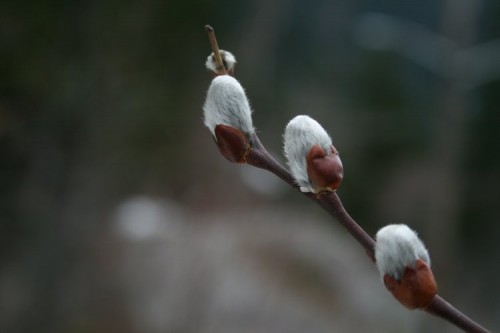Twig tracking: a sport for the impatient

A winter weather advisory is currently in effect for the west slopes of the Cascades, the trails around the learning center are covered with deep, crusty snow and still the buds on trees and shrubs around the learning center are hinting that they will soon open. There are too many reasons to list for loving this season; among them are the anticipation of spring, the splendor it prompts, a plethora of opportunities for questioning, observing and marveling, and astonishment at the resilience of nature.
I’m getting ahead of myself. I should start this post with a warning. I’m impatient. This is a fact that is recognized by many people in my life. I often joke that my twin sister got all of the patience. All of it. This character trait prompted me to explore the learning center a few days ago. I was in search of the first spring buds.
The Indian Plum wins the first place prize. As I compose this post the buds on a number of Indian plums around the learning center are on the verge of bursting open. Each time I walk by one of these shrubs, graced with striking pinkish, green buds, it seems to promise that longer days, lighter rain and blue skies will soon arrive.
 Indian plum buds
Indian plum buds
Next, the willows! The Hooker’s willow seems primed and ready for spring. These unusual buds are intriguing and bring forth the question, why are they this way? What other buds are white and fuzzy? Is it somehow advantageous?
 Hooker’s willow buds
Hooker’s willow buds
The last bud I discovered on my winter exploration was the Pacific Dogwood, also known as the Western Flowering Dogwood. Will it be one of the first buds to open? I don’t know. What keeps me coming back to this shrub, sometimes daily, is the feeling that each bud is a beautifully wrapped gift filled with delicate, oval green leaves just waiting for the opportunity to present themselves, but waiting for the right moment.
 Pacific dogwood buds
Pacific dogwood buds
My exploration of the learning center, in search of the first buds of spring, proved to not only remind me of why I love this season, it also required that I find an answer. Appearances aside, which shrubs do flower first? After doing some research I found that Red flowering currant, Salmonberry, Indian plum, and Hooker’s willow are often the first shrubs of the year to flower. These shrubs all serve as important nectar sources for hummingbirds, bees, early butterflies and insects. In fact the migration of the Rufous Hummingbirds is keyed, in part, to early blooming plants along the Pacific coast of these shrubs.
As you might suspect I’m ready for the hummingbirds, the end of winter weather advisories and the melting of crusty, hard snow. The little patience I could summon has ended and I am now eagerly awaiting the explosion of color, scents, and sounds that spring ushers in and the plethora of life that follows it.


What compelling writing. Makes me want to have my feet in the crusty, lessening snow, peering at the buds, awaiting the glory of spring lushness. Thank you for the images.
Wonderful pictures and comments Jenny. I am waiting for the day when it will snowing plum blossoms here in my yead in Bellingham. Our 5th graders from Birchwood will arrive there tomorrow, weather permitting. Say hi to Emily for me.
Mona
Thanks to you Jenny I have become sooooo observant of twigs and the tiny life on them that is already here to greet us! Sometimes we just need to meet a certain person to open our eyes a little bit wider….
You are fabulous Jenny!
-Katie Trujiilo